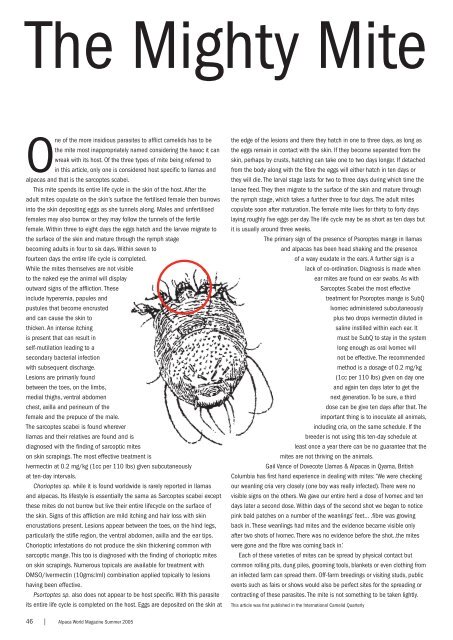Alpaca World Magazine Summer 2005 - Classical MileEnd Alpacas
Alpaca World Magazine Summer 2005 - Classical MileEnd Alpacas
Alpaca World Magazine Summer 2005 - Classical MileEnd Alpacas
- No tags were found...
Create successful ePaper yourself
Turn your PDF publications into a flip-book with our unique Google optimized e-Paper software.
The Mighty MiteOne of the more insidious parasites to affl ict camelids has to bethe mite most inappropriately named considering the havoc it canwreak with its host. Of the three types of mite being referred toin this article, only one is considered host specifi c to llamas andalpacas and that is the sarcoptes scabei.This mite spends its entire life cycle in the skin of the host. After theadult mites copulate on the skin’s surface the fertilised female then burrowsinto the skin depositing eggs as she tunnels along. Males and unfertilisedfemales may also burrow or they may follow the tunnels of the fertilefemale. Within three to eight days the eggs hatch and the larvae migrate tothe surface of the skin and mature through the nymph stagebecoming adults in four to six days. Within seven tofourteen days the entire life cycle is completed.While the mites themselves are not visibleto the naked eye the animal will displayoutward signs of the affl iction. Theseinclude hyperemia, papules andpustules that become encrustedand can cause the skin tothicken. An intense itchingis present that can result inself-mutilation leading to asecondary bacterial infectionwith subsequent discharge.Lesions are primarily foundbetween the toes, on the limbs,medial thighs, ventral abdomenchest, axilla and perineum of thefemale and the prepuce of the male.The sarcoptes scabei is found whereverllamas and their relatives are found and isdiagnosed with the fi nding of sarcoptic miteson skin scrapings. The most effective treatment isIvermectin at 0.2 mg/kg (1cc per 110 Ibs) given subcutaneouslyat ten-day intervals.Chorioptes sp. while it is found worldwide is rarely reported in llamasand alpacas. Its lifestyle is essentially the sama as Sarcoptes scabei exceptthese mites do not burrow but live their entire lifecycle on the surface ofthe skin. Signs of this affl iction are mild itching and hair loss with skinencrustations present. Lesions appear between the toes, on the hind legs,particularly the stifl e region, the ventral abdomen, axilla and the ear tips.Chorioptic infestations do not produce the skin thickening common withsarcoptic mange. This too is diagnosed with the fi nding of chorioptic miteson skin scrapings. Numerous topicals are available for treatment withDMSO/Ivermectin (10gms:lml) combination applied topically to lesionshaving been effective.Psortoptes sp. also does not appear to be host specifi c. With this parasiteits entire life cycle is completed on the host. Eggs are deposited on the skin atthe edge of the lesions and there they hatch in one to three days, as long asthe eggs remain in contact with the skin. If they become separated from theskin, perhaps by crusts, hatching can take one to two days longer. If detachedfrom the body along with the fi bre the eggs will either hatch in ten days orthey will die. The larval stage lasts for two to three days during which time thelarvae feed. They then migrate to the surface of the skin and mature throughthe nymph stage, which takes a further three to four days. The adult mitescopulate soon after maturation. The female mite lives for thirty to forty dayslaying roughly fi ve eggs per day. The life cycle may be as short as ten days butit is usually around three weeks.The primary sign of the presence of Psoroptes mange in llamasand alpacas has been head shaking and the presenceof a waxy exudate in the ears. A further sign is alack of co-ordination. Diagnosis is made whenear mites are found on ear swabs. As withSarcoptes Scabei the most effectivetreatment for Psoroptes mange is SubQIvomec administered subcutaneouslyplus two drops ivermectin diluted insaline instilled within each ear. Itmust be SubQ to stay in the systemlong enough as oral Ivomec willnot be effective. The recommendedmethod is a dosage of 0.2 mg/kg(1cc per 110 Ibs) given on day oneand again ten days later to get thenext generation. To be sure, a thirddose can be give ten days after that. Theimportant thing is to inoculate all animals,including cria, on the same schedule. If thebreeder is not using this ten-day schedule atleast once a year there can be no guarantee that themites are not thriving on the animals.Gail Vance of Dovecote Llamas & <strong>Alpaca</strong>s in Qyama, BritishColumbia has fi rst hand experience in dealing with mites: ‘We were checkingour weanling cria very closely (one boy was really infected). There were novisible signs on the others. We gave our entire herd a dose of Ivomec and tendays later a second dose. Within days of the second shot we began to noticepink bald patches on a number of the weanlings’ feet... .fi bre was growingback in. These weanlings had mites and the evidence became visible onlyafter two shots of Ivomec. There was no evidence before the shot..the miteswere gone and the fi bre was coming back in.’Each of these varieties of mites can be spread by physical contact butcommon rolling pits, dung piles, grooming tools, blankets or even clothing froman infected farm can spread them. Off-farm breedings or visiting studs, publicevents such as fairs or shows would also be perfect sites for the spreading orcontracting of these parasites. The mite is not something to be taken lightly.This article was fi rst published in the International Camelid Quarterly46 | <strong>Alpaca</strong> <strong>World</strong> <strong>Magazine</strong> <strong>Summer</strong> <strong>2005</strong>







